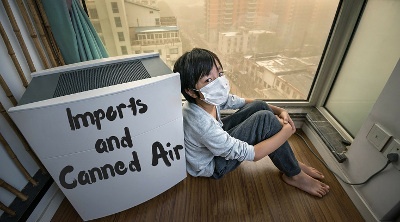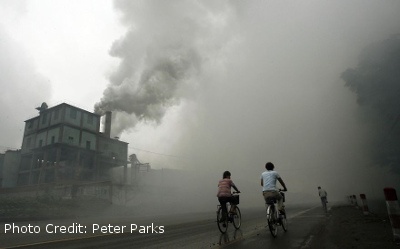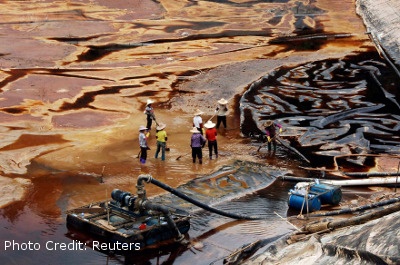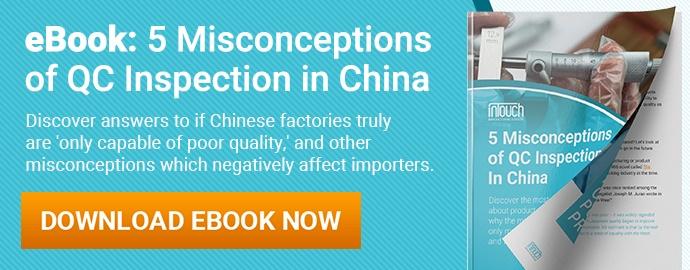 I saw a story earlier this week that was so outrageous I just had to share it with you. A Canadian company called Vitality Air sold 500 canisters of Canadian air to Chinese shoppers. They reportedly sold out “almost instantly”, selling the canned air over Taobao, China’s major eCommerce website. And by the way, the cans sold for between $14 and $20 each, depending on the size.
I saw a story earlier this week that was so outrageous I just had to share it with you. A Canadian company called Vitality Air sold 500 canisters of Canadian air to Chinese shoppers. They reportedly sold out “almost instantly”, selling the canned air over Taobao, China’s major eCommerce website. And by the way, the cans sold for between $14 and $20 each, depending on the size.
My initial reaction: laughter at the ridiculous nature of some of China’s hive-like consumer habits.
But my laughter soon gave way to concern.
The news came just a week after Beijing issued a “red alert” for pollution in the city. Schools, construction sites and traffic were all cut due to an air quality index of 250. To put that into perspective, that’s 10 times higher than what the World Health Organization considers “healthy” levels. Much of the city’s workforce stayed indoors to avoid the hazardous air.
I remember staying up late as a kid the night of a nor’easter-type snowstorm in my hometown of Bolton, Massachusetts. I’d be fixated on news reports and anxiously anticipating news of school cancelation the following day – a snow day. Now Chinese kids are facing school cancelation due to something very different – a pollution day.
Just how serious is China’s pollution problem? How has it affected other countries, including the U.S.? And how can importers address the problem in their own supply chain?
The severity of the global pollution problem
You’ve certainly heard terms like “global warming” to describe the general heating of the earth and the possible consequences resulting from human-generated pollution. Many of us point fingers at China, which according to the Emission Database for Global Atmospheric Research (EDGAR), has consistently ranked highest for CO2 emissions by country since at least 2005.
But China remains a major manufacturing hub for goods exported to other countries– a factory to the world. In this way, we can see how importers share some of the responsibility for growing pollution concerns.
"China has consistently ranked highest for CO2 emissions by country since at least 2005."Are you importing China’s pollution?
Consider that electronic equipment accounted for 24 percent of China’s exports in 2014. And electronic waste makes up a significant portion of China’s pollution. In fact, 70 percent of annual global e-waste is dumped in China. Processing this e-waste involv es burning and heating components to extract valuable materials, which releases harmful toxins.
es burning and heating components to extract valuable materials, which releases harmful toxins.
Basically, those mobile phones, tablet PCs, laptops and TV sets we all value so much, might actually have contributed to pollution to China not once but twice–first in the manufacturing process and then in the recycling process.
Now you might be thinking “out of sight, out of mind”, which is understandable
But articles about China’s pollution migrating to the United States are worth considering. Researchers from the U.S. National Academy of Sciences were able to link smog levels in Los Angeles to air pollutants from goods manufactured for export in China. This isn’t news to Japan and South Korea, two neighboring countries that have seen clouds of pollution blow over from China for decades.
"70 percent of annual global e-waste is dumped in China."Consequences of pollution: the Love Canal example
To fully grasped the consequences of pollution, we don’t have to look far to see to see an example. The Love Canal neighborhood in New York remains an historical example of how pollution can impact a community.
The story of Love Canal began when a company buried barrels of toxic chemicals in a canal in the 1950s. The canal was later filled and the land sold to the local town. The town then developed the land above the canal, building homes and a public school.
The barrels of chemicals soon leaked and began seeping up through the soil and foundations of peoples’ homes. The consequences weren’t fully understood until the late 1970s. Children in Love Canal were born with significant developmental issues–mental challenges, cleft pallet, an extra row of teeth and other birth defects.
President Jimmy Carter announced a federal health emergency and allocated federal funds to remedy the site. More than 800 families were relocated. In addition, the company responsible was forced to pay more than $120 million in restitution for negligence. It’s still unclear how many lives were affected, both directly and indirectly, by what initially seemed to be a local and isolated incident.
How bad is China’s pollution?
| Top 10 Chinese cities with the worst air quality | |
| Rank | City, Province |
| 1 | Baoding, Hebei |
| 2 | Xingtai,Hebei |
| 3 | Shijiazhuang, Hebei |
| 4 | Tangshan, Hebei |
| 5 | Handan, Hebei |
| 6 | Hengshui, Hebei |
| 7 | Jinan, Shandong |
| 8 | Langfang, Hebei |
| 9 | Zhengzhou, Henan |
| 10 | Tianjin |
Now we’re clear that pollution can migrate across entire oceans, and we understand that pollution can have serious ramifications for those in affected areas. Let’s look at some hard facts about China’s deadly pollution problem:
- Cancer has become China’s leading cause of death due to industrial pollution
- 500 million Chinese lack clean and safe drinking water
- 1.6 million people die each year from lung, heart and stroke problems related to polluted air in China
China is taking action to cut pollution, such as limiting the number of cars on the road to reduce smog in Beijing. China's Cabinet also recently announced plans to cut pollution from coal-fired power plants 60 percent by 2020. But many wonder if the government's ambitious targets for economic growth might interfere with green initiatives.
How can importers cut pollution?
The question of how to reduce pollution has a complex answer. For some governments, emissions trading is one method that comes to mind. Another method is exporting the industries that generate pollutants to other regions or countries.
Eight of the top ten Chinese cities with the worst air pollution are located in Hebei Province to the North. The Chinese government has resolved to relocate some of the most polluting factories to Latin America, Africa, Eastern Europe and other Asian countries. Reducing concentration by relocating factories can limit the number of people immediately affected. But as we’ve seen, pollution spreads and is a far-reaching, global problem.
How can you, as an importer, hope to combat pollution in your own supply chain?
ISO 14001
When you want to cut pollution in your supply chain you have to begin by investigating the suppliers that manufacture your goods.
One way many importers are investigating their suppliers is through an environmental audit that uses the ISO 14001 standard. Similar to how the ISO 9001 standard looks at a factory’s quality management systems, the ISO 14001 standard assesses a factory’s environmental management systems. An audit following the standard can reveal ways that a factory can prevent or reduce pollution.
 In addition, there are a number of potential hidden benefits as well, including:
In addition, there are a number of potential hidden benefits as well, including:
- A reduction in production waste and operating costs
- Higher conformance to regulatory requirements
- Greater corporate social responsibility and public image; and
- A reduction in public liability insurance costs in some markets
A Quality and CSR Director of a Spanish construction company spoke of the benefits of ISO 14001: “[ISO 14001] helped us to improve our environmental impact significantly. In 2014 alone, we cut our carbon emissions by more than 23 tons, our dust production by more than 20 tons and we reused 116 m of water.”
Auditing your suppliers is one of the best ways to find out how much pollution you may be contributing through the manufacture of your products. And once you know the extent of any pollution involved, you can work with the supplier to develop corrective and preventive action plans to address it.
Conclusion
The problems associated with China’s pollution are undeniable. People aren’t just experiencing a scratchy throat or worse visibility due to smog–some are actually dying as a result. And manufacturing represents a significant source of pollution not only in China, but globally.
Whether industries are operating domestically or abroad, the fact remains that pollution is continuously being released into the air we breathe. It’s seeping into the water we drink. And it’s percolating up through the soil in which we grow our food and on which we build our homes.As an importer, you can be part of the solution, instead of part of the problem. Audit your suppliers’ environmental management system.
As an importer, you have the opportunity to be part of the solution by auditing a supplier’s environmental management system.
"As an importer, you can be part of the pollution solution, instead of part of the problem."I'll conclude with a quote from Theodore Roosevelt, a late American president and renowned conservationist: “Cherish these natural wonders, cherish the natural resources, cherish the history and romance as a sacred heritage, for your children and your children's children. Do not let selfish men or greedy interests skin your country of its beauty, its riches or its romance.”







